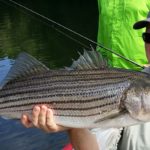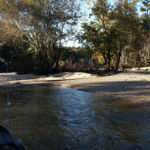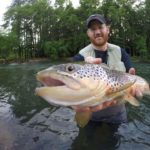
The lower Saluda River around Columbia offers April anglers with tremendous opportunities to catch trout and striped bass in places many would not expect to find them.
Rather than packing the truck and making a long drive to the Upstate, the lower Saluda River offers trout fishermen a unique opportunity in the Midlands. Stocked during the winter by the S.C. Department of Natural Resources, the lower Saluda in and around Columbia is filled with quality browns and rainbows.
Not only does the river offer excellent fishing for trout, but in the spring, striped bass work their way up the Congaree River, looking for cold water as they prepare to spawn. Many anglers find that April is prime time to get a meet up with a big striper near the junction of the Congaree and lower Saluda.
Jake Howard of Saluda Valley Guide Service grew up fishing the lower Saluda and began guiding in 2013. Despite its proximity to Columbia, the river is a mystery to many anglers who aren’t sure how to approach waters that are often difficult to fish and sometimes dangerous. Howard has a few tips for anglers who want to understand the fishery and hook up with a nice trout or striper this month.
“The lower Saluda River is a put-and-take river where SCDNR stocks rainbow and brown trout for anglers to catch and keep for food purposes,” Howard said. “Luckily, conditions in the Saluda are conducive for fish not taken out by fisherman to live through the warmer months and grow rapidly. Holdover fish have become more and more common and have become the basis of the breeding population in the river.”
The ability of trout to hold over from year to year is enhanced by the colder water that comes off the bottom of Lake Murray and is discharged through the dam into the river. It’s essentially a tailrace fishery, even though it extends for miles and miles downstream from the tailrace.
“In the spring, the trout move up into the faster shoals where oxygen is highest and food is most abundant,” Howard said. “Trout are most active when water temperatures are between 50 and 60 degrees. This means they feed most actively during these times.
“Ninety percent of the fish live in 10 percent of the water. Figure out where the fish want to be that day, and when you find them, fish water that has the same characteristics.”
Howard said the river has plenty of aquatic and insect life that provides food for the bigger predator fish.
“The Saluda holds a surprising variety of insect life in the spring,” he said. “A larger spectrum of mayflies, from small Blue Winged Olives to large Pale Morning and Evening Duns can be found on the river. Adams and Parachute Adams in a variety of sizes are great imitations. Most fish will be caught subsurface on nymphs. Typically, productive nymphs include Hare’s Ear and Pheasant Tails along with Caddis pupa.”
The key to successful trout fishing is getting you gear right. Howard guides primarily with fly-fishing gear but will also accommodate people who prefer to use spinning tackle.
“When I guide for trout, I like to use a 9-foot, 5-weight Scott A4 rod with a Lamson Remix reel spooled with Scientific Anglers Mastery textured line. Ultralight or light-action 6-foot spinning outfits spooled with 6-pound test line work well on the river. Companies like St. Croix make excellent spinning rods specifically for trout fishing if anglers do not want to use fly-fishing gear.”
In the spring, the river around Columbia is home to the largest migration of landlocked stripers on the east coast.
“There are tight regulations that close all fishing for them from June 1 to the end of September,” Howard said, “so the only time to catch them is in April and May. They typically show up in the upper Congaree near the Saluda around April before moving up the lower Saluda in the summer.”
Anglers fishing the mouth of the lower Saluda near its junction with the Congaree have to opportunity for some quality striper fishing as they migrate upstream.
”Fish everywhere; they could be stacked in a deep hole or schooling in the rocks,” Howard said. “Flies that imitate shad work best. White and/or chartreuse color is best — or black if the water is muddy. Use a variety of topwater and sub-surface baits and flies. It can change throughout the day.”
“For smaller fish, a 6-weight will work, but an 8-weight is recommended to cover more water with long casts,” Howard said. “A 9-foot, 8-weight Scott Tidal or Meridian with a Lamson Speedster 3.5 spooled with Scientific Anglers Mastery Titan Taper works well with a 20-pound leader to cast larger, heavier flies. Spinning rods should be at least 7-foot, in medium to medium-heavy action. St. Croix’s Legend Ultra with a Penn Battle 4000 spooled with 30-pound Power Pro (braid) is my favorite setup.”
Howard recommends that angers use extreme caution when fishing the rivers around Columbia.
“Keep an eye on water levels,” he said. “It can get very dangerous, very quickly if the flows increase.”
DESTINATION INFORMATION
HOW TO GET THERE — The lower Saluda River runs through Columbia, with several boat landings on either side of the river. Saluda Shoals State Park and Hope Ferry Landing offer anglers both a boat ramp and shoreline fishing opportunities. Downstream, Gardendale Area Access is a popular exit point. For a complete list of river access points, visit http://www.thestate.com/living/living-here-guide/article14407799.html.
WHEN TO GO — The lower Saluda River offers excellent trout fishing in the winter and spring. Striper fishing begins to heat up in mid-April when fish begin migrating up the Congaree to spawn.
BEST TECHNIQUES — Float fishing or fishing from a shoreline access point with a nymph or mayfly pattern will work on trout. Target faster shoals, which will offer more oxygen in the water for the fish. When targeting stripers, fish were they will be migrating in the upper Congaree. Cast around with shad and baitfish imitation flies and lures.
FISHING INFO/GUIDES — Jake Howard, Saluda Valley Guide Service, 803-312-2435, www.saludavalleyguidesllc.weebly.com; Barron’s Outfitters, 803-254-5537. See also Guides and Charters in Classifieds. For information on water flow in the lower Saluda, contact SCE&G, 800-251-7234.
ACCOMMODATIONS — Columbia Chamber of Commerce, http://discoversouthcarolina.com/columbia
MAPS — Lower Saluda River Fishing/Canoeing/Kayaking Map, – https://www.google.com/maps




Be the first to comment